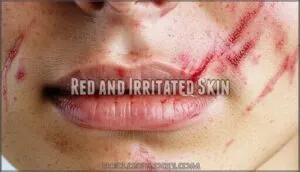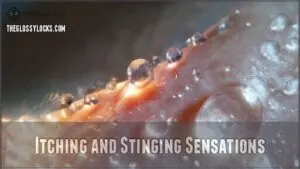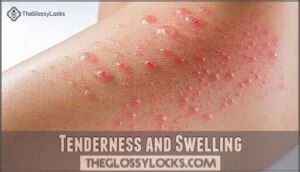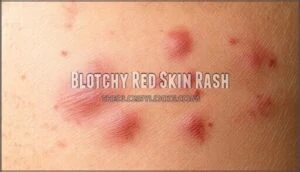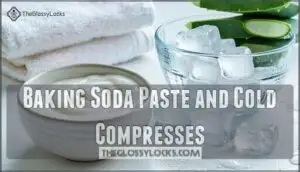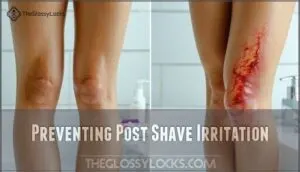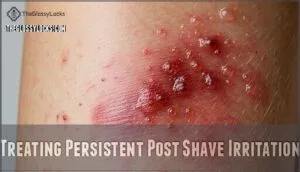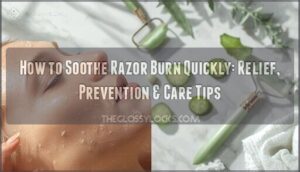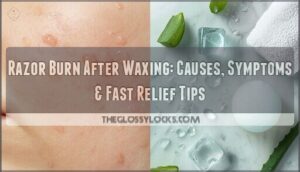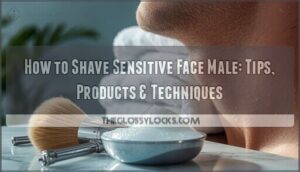This site is supported by our readers. We may earn a commission, at no cost to you, if you purchase through links.
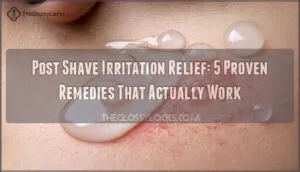
Post shave irritation relief starts with immediate cooling—grab a cold, damp washcloth and press it against angry skin for instant comfort. Aloe vera gel works like nature’s fire extinguisher, while witch hazel acts as your skin’s best friend by reducing inflammation.
You can also create a simple baking soda paste with water to neutralize irritation. Think of these remedies as first aid for your face.
The real game-changer isn’t just treating the problem—it’s understanding why your skin rebels and how simple tweaks to your routine can prevent future battles. This approach involves making simple tweaks to your daily routine, which can lead to significant improvements in your skin’s health, ultimately providing instant comfort.
Table Of Contents
- Key Takeaways
- Causes of Post Shave Irritation
- Symptoms of Post Shave Irritation
- Remedies for Post Shave Irritation
- Preventing Post Shave Irritation
- Treating Persistent Post Shave Irritation
- Frequently Asked Questions (FAQs)
- How to calm irritated skin after shaving?
- How long does post-shave irritation last?
- How do you get rid of shaving rash down there fast?
- What products help irritated skin after shaving?
- How long does post shave irritation typically last?
- Can razor burn be mistaken for other conditions?
- Whats the difference between razor burn and bumps?
- Are certain body areas more prone to irritation?
- When should you see a doctor about irritation?
- Conclusion
Key Takeaways
- Cool down angry skin immediately – You’ll get instant relief by pressing a cold, damp washcloth against irritated areas, then follow up with aloe vera gel or witch hazel to reduce inflammation and redness.
- Prevention beats treatment every time – You can avoid razor burn by using sharp, clean blades, shaving with the grain, applying proper lubrication, and skipping alcohol-based aftershaves that’ll dry out your skin.
- Simple household remedies work wonders – You don’t need expensive products when baking soda paste, oatmeal baths, tea tree oil, and coconut oil can soothe irritation just as effectively.
- Know when to seek help – You should see a doctor if irritation persists beyond three days, shows signs of infection like pus or spreading redness, or if you develop a fever alongside the skin irritation.
Causes of Post Shave Irritation
You’ve probably wondered why your skin feels like it’s on fire after what seemed like a perfectly normal shave.
The culprits behind post-shave irritation are usually simple mistakes like using a dull razor, skipping shaving cream, or dragging the blade against your hair’s natural growth direction.
These common errors can turn your daily routine into an uncomfortable experience, often due to mistakes like using a dull razor or skipping shaving cream.
Shaving Without Lubrication
Dry shaving forces your razor blade against unprotected skin, dramatically increasing blade contact force and causing immediate hair follicle trauma.
Dragging a razor across dry skin is like sandpaper on silk—pure trauma for your follicles.
Without proper lubrication, you’re basically scraping away your skin’s protective barrier, leading to severe irritation and razor burn.
This harsh friction multiplies dry shaving risks, making your post-shave experience unnecessarily painful and requiring intensive skin irritation relief afterward.
Using shaving cream provides essential lubrication to minimize friction.
Using Dull or Old Blades
Your razor blades lose their edge faster than you’d expect.
Dull blades drag across your skin, creating micro-tears that lead to razor burn and shaving irritation relief becomes necessary.
A good way to avoid this is to buy quality blade replacements.
Blade quality directly impacts your comfort:
- Replace cartridge blades after 5-7 shaves maximum
- Single blades dull quicker with daily shaving frequency
- Poor blade materials increase infection risks substantially
- Proper razor maintenance extends blade lifespan considerably
Shaving Against Hair Growth
When you shave against your hair’s natural growth direction, you’re asking for trouble.
This backward blade angle forces razor strokes to cut hair below skin level, creating increased irritation and razor burn.
Going against the grain also raises folliculitis risk by allowing bacteria into damaged follicles.
The wrong shaving direction practically guarantees ingrown hairs and unnecessary skin damage.
Sensitive Skin and Irritating Products
Some people have naturally sensitive skin that reacts poorly to certain product ingredients.
Fragrances, alcohol, and harsh chemicals in shaving creams can trigger skin irritation even with perfect technique.
You’ll want alcohol free aftershave and shave cream sensitive skin formulas.
Always do patch testing before trying new products.
Choose gentle exfoliation methods and aftershave balm for irritation prevention.
Dry Shaving and Improper Razor Maintenance
Your razor’s cleanliness directly impacts your skin’s health.
Dry shaving without proper lubrication alternatives strips away natural oils, while poor blade hygiene introduces bacteria.
Inadequate skin prep and irregular shaving frequency worsen razor burn.
Improper razor storage dulls blades faster, requiring more pressure during shaving, creating the perfect storm for skin irritation and razor maintenance nightmares.
Symptoms of Post Shave Irritation
You’ll know you’ve got post-shave irritation when your skin looks red and feels like it’s throwing a small tantrum after your shave.
The telltale signs include stinging, itching, tenderness, and those unmistakable blotchy red patches that make you wish you’d skipped the razor altogether.
Red and Irritated Skin
After understanding what triggers post shave irritation, you’ll notice the telltale signs appearing within hours.
Redness develops as your skin’s inflammatory response kicks in, creating blotchy patches that signal underlying skin sensitivity.
Post shave care becomes critical when you spot these warning signs:
- Streaky red marks following razor blade paths
- Inflamed patches with increased skin irritation
- Hot, flushed areas indicating active inflammation
- Visible redness requiring immediate healing time attention
Itching and Stinging Sensations
Beyond the visible redness, your skin’s sensory receptors are firing warning signals.
That familiar itching and stinging sensation hits when inflammation triggers nerve involvement, creating an uncomfortable burning feeling.
Your pain thresholds vary based on skin sensitivity, making some areas feel worse than others.
The psychological impact of persistent skin irritation can be frustrating, especially when post shave irritation disrupts your daily routine.
Tenderness and Swelling
Following your shave, tenderness and swelling transform your skin into a battlefield of inflammation.
These uncomfortable symptoms signal your body’s natural response to razor damage, requiring immediate skin soothing attention.
5 Key Signs of Post-Shave Tenderness:
- Sensitive areas feel raw when touched
- Pain management becomes necessary for daily activities
- Swelling reduction needed around hair follicles
- Inflammation causes visible puffiness
- Healing timeline extends without proper care
Blotchy Red Skin Rash
Beyond the tender, swollen feeling comes the telltale blotchy red skin rash that screams "razor burn."
Your freshly shaved skin shouldn’t look like an angry tomato—here’s how to fix that fiery mess.
This shaving rash creates patches of angry redness across your skin, looking like you’ve been sunburned in weird streaks.
The skin irritation varies in severity, but redness relief is possible with proper care.
Quality shaving creams can help prevent this irritation.
| Rash Appearance | Severity Levels | Sensitive Areas |
|---|---|---|
| Patchy red streaks | Mild to moderate | Face and neck |
| Blotchy irritation | Can worsen daily | Underarms, legs |
| Uneven skin redness | Fades in 2-3 days | Bikini line area |
Remedies for Post Shave Irritation
When razor burn strikes after shaving, you don’t have to suffer through the stinging and redness until it heals on its own.
Simple household items like cool washcloths, aloe vera gel, and even oatmeal can provide quick relief and help your skin recover faster than waiting it out.
Cool Washcloth Application
When your skin’s screaming after a shave, grab a cool washcloth for immediate relief.
This simple cooling aftershave technique tackles inflammation head-on, providing redness relief within minutes.
Here’s your game plan:
- Compress Temperature: Use cold water, not ice-cold
- Application Duration: Hold for 5-10 minutes maximum
- Washcloth Material: Choose soft cotton for skin sensitivity
This skin soothing technique works like magic on irritation.
Aloe Vera Gel and Natural Oils
Nature’s pharmacy offers potent aloe vera and natural oils for razor burn treatment.
Pure aloe vera gel delivers anti-inflammatory compounds that reduce redness within hours. Coconut oil’s antiseptic properties complement jojoba oil’s skin-mimicking abilities.
Apply these natural remedies directly to irritated areas, reapplying as needed.
Discover aloe vera products for various skin types. Choose organic, additive-free products for maximum skin irritation relief and post shave irritation relief to get the best results with natural remedies.
Oatmeal Baths and Colloidal Oatmeal
Oatmeal baths offer surprisingly effective razor burn treatment through colloidal oatmeal’s anti-inflammatory properties.
You’ll find relief by grinding one cup of oats into fine powder, then sprinkling it under running bath water.
The oatmeal benefits include skin soothing through beta-glucans and phenols, and by soaking for fifteen minutes, allowing skin absorption of these healing compounds for irritated skin relief.
Tea Tree Oil and Witch Hazel
With their powerful anti-inflammatory and antimicrobial properties, tea tree oil and witch hazel make an excellent combination for treating skin irritation.
You’ll need to dilute tea tree oil with a carrier oil before applying it to sensitive skin.
Witch hazel acts as a natural astringent, reducing redness while tea tree oil prevents infection.
These product combinations offer proven tea tree benefits and witch hazel uses.
Baking Soda Paste and Cold Compresses
While baking soda lacks scientific backing, many swear by its cooling effects for razor burn relief.
Mix baking soda with water to create a gentle paste, then apply to irritated areas.
Cold compresses work differently—they relax inflamed skin and reduce redness immediately.
Both natural remedies offer compress application tips that cost pennies compared to expensive treatments for skin irritation.
For a soothing alternative, consider aloe vera application to reduce irritation and promote healing with natural remedies.
Preventing Post Shave Irritation
You don’t have to suffer through razor burn every time you shave if you know the right prevention tricks.
Simple changes to your shaving routine can save your skin from turning into a red, angry mess that makes you regret picking up that razor in the first place, which can be avoided with the right prevention tricks.
Exfoliating With Salicylic or Glycolic Acid
Smart exfoliation prevents razor bumps before they start. Salicylic acid penetrates deep to unclog pores, while glycolic acid removes dead skin cells from the surface.
Consider using a salicylic acid product for best results.
Here’s your game plan:
- Start with lower concentrations (2% salicylic or 5% glycolic) to test your skin’s tolerance
- Exfoliate 2-3 times weekly – overdoing it backfires spectacularly
- Match the acid to your skin type – oily skin loves salicylic, dry skin prefers glycolic
Using Sharp and Clean Razors
Your razor’s sharpness directly impacts your skin’s health.
Dull blades require multiple passes, increasing friction and razor burn risk.
Replace cartridges after 5-7 shaves, depending on razor quality.
Clean your razor with warm water after each use, removing hair and debris.
Store razors in dry locations to prevent bacterial growth.
Proper razor maintenance and quality blade material prevent shaving rash better than expensive cleaning solutions.
Shaving With The Grain and Lubrication
Following the grain direction prevents hairs from being cut too short and curling back into skin.
Apply pre-shave oils or quality shaving cream before each stroke—your skin needs that protective barrier. Hold your razor at a 30-degree angle and let the blade do the work.
These shaving techniques guarantee a smooth, comfortable shave without the painful aftermath.
Avoiding Tight Clothing and Alcohol-based Products
After proper shaving technique, your fabric choice matters too.
Tight clothing creates clothing friction against freshly shaved skin, trapping heat and preventing skin breathability.
Choose loose-fitting garments for better irritation prevention.
Skip alcohol-based aftershaves that sting and dry out sensitive skin.
Instead, opt for alcohol free aftershave and alcoholfree products designed for skin sensitivity and gentle skin irritation prevention.
Considering Laser Hair Removal
You’re tired of razor burn ruining your day? Laser hair removal might be your escape route from shaving struggles.
This treatment targets hair follicles with heat, reducing growth and eliminating razor burn inflammation permanently.
- Laser cost factors vary by area size and clinic location
- Treatment effectiveness works best on dark hair and light skin
- Pain management involves cooling gels and numbing creams
- Skin type suitability requires professional consultation first
- Long-term effects include reduced hair thickness and smoother skin
Treating Persistent Post Shave Irritation
When your razor burn won’t quit after a few days, it’s time to bring out stronger treatments that target stubborn inflammation and potential infection.
You’ll need medical-grade creams and targeted care routines to calm your angry skin and prevent the irritation from becoming a recurring nightmare.
Hydrocortisone Cream and Antibiotic Creams
When razor burn refuses to budge, hydrocortisone cream tackles inflammation and redness with topical steroids.
However, cream application requires caution—side effects include skin thinning and discoloration. Prescription strength versions pack more punch but demand medical supervision.
Topical antibiotic cream fights bacterial infections, though overuse risks antibiotic resistance. Choose wisely based on your specific symptoms.
You can prevent razor burn by using proper shaving techniques.
Calendula Cream and Benzoyl Peroxide
Beyond topical steroids, calendula cream offers gentle healing properties that reduce razor burn inflammation naturally.
This herbal remedy soothes irritated skin while promoting faster recovery.
Benzoyl peroxide tackles bacterial buildup and clears clogged pores, though watch for drying side-effects.
Combined usage works best when applying calendula first, then spot-treating with lower peroxide strength.
- Golden calendula flowers transformed into soothing anti-inflammatory cream
- Benzoyl peroxide’s bubbling action clearing bacteria-filled razor bumps
- Gentle cream application spreading relief across red, irritated skin patches
- Strategic combined usage creating a one-two punch against shaving rash
Consulting a Doctor for Persistent Symptoms
When razor burn lingers beyond three days, it’s time for a doctor consultation.
Persistent redness or severe inflammation signals your skin needs professional help. Watch for infection indicators like pus, blisters, or worsening symptoms.
If home remedies cause treatment side-effects or fail completely, medical experts can offer alternative options including prescription treatments for stubborn skin irritation. Selecting aftershaves with non-comedogenic ingredients can also help prevent irritation.
Signs of Infection and Folliculitis
Watch for warning signs that your post-shave irritation has become something more serious.
Pus or blisters, spreading redness beyond the original area, and persistent pain signal infection.
Fever symptoms and swollen lymph nodes mean it’s time for doctor consultation.
Folliculitis develops when bacteria invade hair follicles, creating painful bumps filled with pus that won’t heal alone, which can lead to more serious conditions if not treated, characterized by persistent pain and fever symptoms.
Proper Razor Hygiene and Skin Care Routines
Maintaining clean equipment and developing solid skin care routines prevents recurring shaving issues.
Replace blades every 5-7 shaves, rinse your razor thoroughly after each use, and store it in a dry place.
Your pre-shave prep should include warm water and quality shaving cream.
Post-shave care means applying moisturizer immediately, and to get the best results, match your routine to your specific skin type.
Frequently Asked Questions (FAQs)
How to calm irritated skin after shaving?
Cool compresses, aloe vera, and moisturizing oils work wonders for angry skin.
Skip alcohol-based products that’ll sting like crazy.
Give your skin breathing room with loose clothing, and let time do its healing magic.
How long does post-shave irritation last?
Post-shave irritation typically lasts anywhere from a few hours to three days.
Your skin usually heals on its own during this time.
If redness and bumps persist beyond a week, you’ll want to consult a healthcare provider.
How do you get rid of shaving rash down there fast?
Apply cool aloe vera gel immediately after shaving to soothe inflammation.
Use hydrocortisone cream for severe irritation.
Avoid tight clothing and take a break from shaving until your skin heals completely.
What products help irritated skin after shaving?
Why suffer through burning, stinging skin when relief’s within reach?
You’ll find comfort using aloe vera gel, coconut oil, or hydrocortisone cream.
Cold compresses and witch hazel also soothe irritated areas effectively.
How long does post shave irritation typically last?
Razor burn typically clears up within a few hours to three days on its own.
You’ll notice the redness and irritation fade as your skin heals naturally, especially if you avoid shaving the affected area.
Can razor burn be mistaken for other conditions?
Don’t judge a book by its cover—razor burn can look like other skin problems.
You might confuse it with herpes, which causes fluid-filled blisters, or folliculitis, which creates infected bumps.
Whats the difference between razor burn and bumps?
Understanding these two conditions helps you tackle post-shave problems effectively.
Razor burn appears immediately as red, irritated skin from improper shaving techniques.
Razor bumps develop later as ingrown hairs create small, pimple-like bumps, which can be considered post-shave problems that appear due to improper shaving techniques.
Are certain body areas more prone to irritation?
Yes, your neck, pubic area, and underarms face higher irritation risks.
These spots have sensitive skin, curly hair that grows in different directions, and delicate tissue that’s easily damaged by shaving.
When should you see a doctor about irritation?
See a doctor if irritation persists beyond several days, shows signs of infection like pus or spreading redness, develops blisters, or you experience fever alongside the skin irritation.
Conclusion
Remember, post shave irritation relief doesn’t require expensive products or complicated routines.
The most effective solutions often come from your kitchen cabinet—aloe vera, baking soda, and cold compresses work wonders.
Prevention beats treatment every time, so invest in sharp razors and proper technique.
Your skin will thank you for the extra care, and if irritation persists beyond a few days, don’t hesitate to consult a dermatologist for professional guidance.

